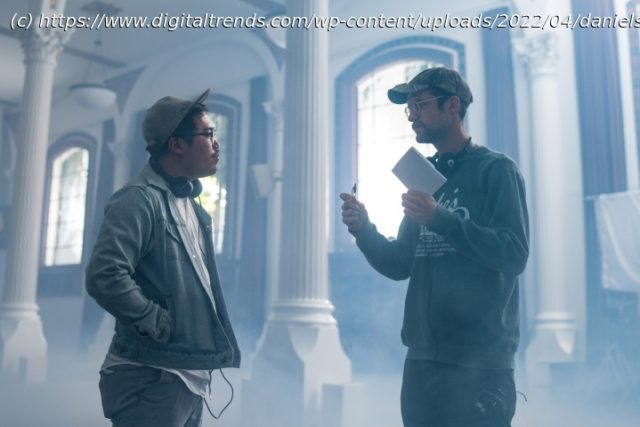Oscar-winning Everything Everywhere All at Once directors Daniel Kwan and Daniel Scheinert discuss their sci-fi film, which won Best Picture at the 2023 Oscars.
Everything Everywhere All at Once is a lot of things: A sci-fi adventure, a martial arts action movie, an absurdist comedy, and now, an Oscar-winning Best Picture at the 2023 Oscars. But above all else, it’s a film about one family and its matriarch, Evelyn Wang (Michelle Yeoh), who embarks on a trip through the multiverse that tests her relationships with her husband, Waymond (Ke Huy Quan), her daughter, Joy (Stephanie Hsu), and her father (James Hong). It’s a personal and intimate journey, and seeing how directors Daniel Kwan and Daniel Scheinert (together, they are known as the “Daniels”) use a massive sci-fi adventure to tell it is one of the many great joys the film has to offer.
It’s an achievement that begins with the film’s opening shot, which shows Evelyn, Waymond, and Joy dancing and singing together. It’s a beautiful moment, but it’s also shown through the reflection of a living room mirror, and therein lies the brilliance of the shot itself. In a film about the multiverse, the opening image of Everything Everywhere All at Once shows viewers just the first of many reflections of Evelyn, Waymond, and Joy that they’ll meet over the course of its story.
While recently speaking with Digital Trends, Kwan, who called the shot a “family portrait,” said it was “embarrassing” how long it took him and Scheinert to land on it as the film’s opening, but it’s one of many inspired creative choices they make in Everything Everywhere All at Once. Below, the directors open up to Digital Trends about some of the film’s most striking visual moments, explain how they wanted it to be different from 2016’s Swiss Army Man, and even reveal the five essential Michelle Yeoh films they think everyone should see.
Note: This interview has been edited for length and clarity purposes.
Digital Trends: Swiss Army Man takes a lot longer to reveal its emotional core than Everything Everywhere All at Once does. Was it an intentional choice on your part to communicate the film’s emotions earlier this time?
Daniel Kwan: That’s an interesting question. Do you remember what scene made you feel that way?
The moment that comes to mind is when Joy is driving away from her parents’ laundromat. The devastation on her face in that moment is so palpable.
Daniel Kwan: Oh, wow. Well, with Swiss Army Man, we went in with the intention to be like, “Let’s blow up what a movie should be. So that then for the rest of the film, no one really knows what’s going to happen.” You know, which worked for some people and didn’t work for other people, and that’s fine. With this one, we were like, “Let’s explode the movie. But let’s do it really slowly and gently so that people have time to get their feet planted before we take them on this wild roller coaster ride.”
That shot you’re talking about actually wasn’t originally in the script. That was one of the few pickup shots that we did when we realized people weren’t fully grounded in the family. Specifically in the Stephanie Hsu and Michelle Yeoh relationship. We were like, “Oh, we need to make sure everyone knows that this is what the movie is actually about.” So we went back and we shot her just driving. It’s very validating to hear that it was worth going back just for that shot.
Daniel Scheinert: We couldn’t get Joy’s original car back [for that shot], so we got a bunch of tape that was the same color as the other car. The scene is shot in soft focus, so we literally just put tape over a different-colored car because you just see it in the corner of the frame.
You’re not looking at the car in that shot either. You’re looking at Joy’s face.
Daniel Scheinert: Exactly. It’s like, “Who’s looking at the paint job?”
Daniel Kwan: So I will say that even though it wasn’t necessarily a conscious decision to make the emotion and the heart very clear at the beginning, we wanted to make sure that it felt way more conventional and safe at the beginning so we could pull you in with the emotional heart and core [of the film].
Домой
United States
USA — software Oscar-winning Everything Everywhere All at Once directors on creating 2022’s most moving...






